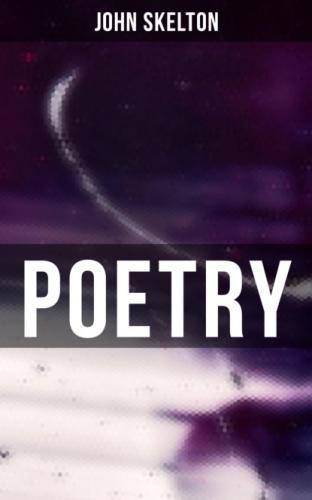“With face so bold, and teeth so sharp,
Of viper’s venome, why dost carp?
Why are my verses by thee weigh’d
In a false scale? may truth be said?
Whilst thou to get the more esteem
A learned Poet fain wouldst seem,
Skelton, thou art, let all men know it,
Neither learned, nor a Poet.”
[104] Vol. i. 419.
[105] See vol. i. 361.
[106] See Notes, vol. ii. 318.
[107] It was granted to him by the king for life.
[108] Vol. i. 419. Concerning this college, see Notes, vol. ii. 334.
[109] A Replycacion agaynst certayne yong scolers abiured of late, &c. vol. i. 206. In Typograph. Antiq. ii. 539. ed. Dibdin, where the Replycacion is described and quoted from Heber’s copy, we are told that it has “a Latin address to Thomas—— who [sic] he [Skelton] calls an excellent patron,” &c. That the editor should have read the address without discovering that the said Thomas was Cardinal Wolsey, is truly marvellous.
[110] Garlande of Laurell, vol. i. 424.
[111] See vol. ii. 83, where this Lenuoy (which will be more particularly noticed presently) is appended to the poem Howe the douty Duke of Albany, &c.
[112] Vol. i. 199.
[113] Animadversions vppon the annotacions and correctōns of some imperfectōns of impressōnes of Chaucers Workes, &c. p. 13—in Todd’s Illust. of Gower and Chaucer.
I may notice here, that among the Harleian MSS. (2252, fols. 156, 158) are two poems on the Cardinal, which in the Catalogue of that collection Wanley has described as “Skelton’s libels;” but they are evidently not by him.
[114] Wolsey had previously been named a Cardinal in 1515.—Fiddes (Life of Wolsey, p. 99. ed. 1726) says that he became Legate a latere in 1516: but see State Papers (1830), i. 9 (note). Lingard’s Hist. of Engl. vi. 57. ed. 8vo, &c.—Hoping to ascertain the exact date of the Replycacion, &c. (which contains the first of the passages now under consideration), I have consulted various books for some mention of the “young hereticks” against whom that piece was written; but without success.
[115] We cannot settle this point by a comparison of old editions, the poem against Albany and the two L’Envoys which follow it being extant only in the ed. of Marshe.—It may be doubted, too, if the L’Envoy which I have cited at p. xli, “Perge, liber,” &c. belongs to the Garlande of Laurell, to which it is affixed in Marshe’s edition as a second L’Envoy: in Faukes’s edition of that poem, which I conceive to be the first that was printed, it is not found: the Cott. MS. of the Garlande is unfortunately imperfect at the end.
[116] i.e. sword.
[117] Chron. (Hen. viii.) fol. cx. ed. 1548.
[118] “Ob literas quasdam in Cardinalem Vuolsium inuectiuas, ad Vuestmonasteriense tandem asylum confugere, pro uita seruanda, coactus fuit: ubi nihilominus sub abbate Islepo fauorem inuenit.” Bale, Script. Illust. Brit. p. 651. ed. 1559.—“Vbi licet Abbatis Islepi fauore protegeretur, tamen vitam ibi, quantumuis antea iucunde actam, tristi exitu conclusit.” Pits, De Illust. Angl. Script. p. 701. ed. 1619.—“But Cardinal Wolsey (impar congressus, betwixt a poor Poet and so potent a Prelate) being inveighed against by his pen, and charged with too much truth, so persecuted him, that he was forced to take Sanctuary at Westminster, where Abbot Islip used him with much respect,” &c. Fuller’s Worthies (Norfolk), p. 257. ed. 1662.—“He [Skelton] was so closely pursued by his [Wolsey’s] officers, that he was forced to take sanctuary at Westminster, where he was kindly entertained by John Islipp the abbat, and continued there to the time of his death.” Wood’s Ath. Oxon. i. 51. ed. Bliss, who adds in a note; “The original MS. register of this sanctuary, which must have been a great curiosity, was in Sir Henry Spelman’s library, and was purchased at the sale of that collection by Wanley for Lord Weymouth. MS. note in Wanley’s copy of Nicholson’s Historical Library in the Bodleian.”
[119] John Islip was elected abbot in 1500, and died in 1532: see Widmore’s Hist. of West. Abbey, 119, 123. “John Skelton … is said by the late learned Bishop of Derry, Nicholson (Hist. Lib. chap. 2.) to have first collected the Epitaphs of our Kings, Princes, and Nobles, that lie buried at the Abbey Church of Westminster: but I apprehend this to be no otherwise true, than that, when he, to avoid the anger of Cardinal Wolsey, had taken sanctuary at Westminster, to recommend himself to Islip, the Abbot at that time, he made some copies of verses to the memories of King Henry the Seventh and his Queen, and his mother the Countess of Richmond, and perhaps some other persons buried in this church.” Account of Writers, &c., p. 5, appended to Widmore’s Enquiry into the time of the found. of West. Abbey.—Widmore is mistaken: neither in Marshe’s ed. of Skelton’s Workes, 1568, nor in the Reges, Reginæ, Nobiles, &c., 1603, is there any copy of verses by our author on the Queen of Henry the Seventh: see in vol. i. 178, 179, 195, the three pieces which I have given from those sources: two of them at least were composed before the poet had sought refuge at Westminster, for one (written at Islip’s request) is dated 1512, and another, 1516; the third has no date.
[120] See p. xxix.
[121] “De morte Cardinalis uaticinium edidit: & eius ueritatem euentus declarauit.” Bale, Script. Illust. Brit. p. 652. ed. 1559.—“The word Vates being Poet or Prophet, minds me of this dying Skeltons prediction, foretelling the ruine of Cardinal Wolsey. Surely, one unskilled in prophecies, if well versed in Solomons Proverbs, might have prognosticated as much, that Pride goeth before a fall.” Fuller’s Worthies (Norfolk), p. 257. ed. 1662.—Did not this anecdote originate in certain verses of Cotyn Cloute? See the fragment from Lansdown MSS., vol. i. 329, note.
[122] “Vuestmonasterii tandem, captiuitatis suæ tempore,
